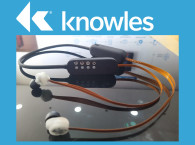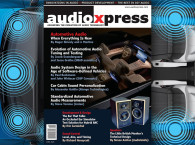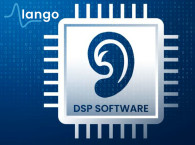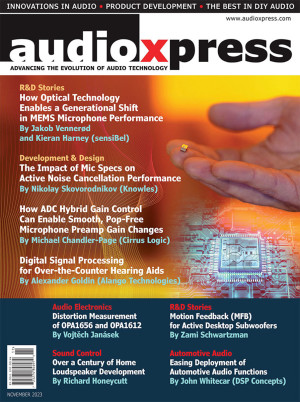 As highlighted on the cover, the November 2023 issue of audioXpress contains a generous amount of reference reading material for those interested in the latest Development & Design trends and practices. The common thread for the main features in this issue relates to digital signal processing, involving multiple approaches of product development and applications, starting with signal capturing, which means microphones.
As highlighted on the cover, the November 2023 issue of audioXpress contains a generous amount of reference reading material for those interested in the latest Development & Design trends and practices. The common thread for the main features in this issue relates to digital signal processing, involving multiple approaches of product development and applications, starting with signal capturing, which means microphones.The first highlight of the November 2023 issue is a world-exclusive, written by Jakob Vennerød and Kieran Harney, both from Norway's optical MEMS pioneer sensiBel. In "How Optical Technology Enables a Generational Shift in MEMS Microphone Performance," the article summarizes the evolution of MEMS microphone technology, outlines the operating principle of optical MEMS microphones, and describes the benefits of optical microphones over conventional solutions. This is a crucial reading to understand how the first generation of optical MEMS microphones have smashed the limits of SNR and dynamic range of miniature microphones, with 80dBA SNR (14dBA noise floor), 132dB dynamic range, 24-bit digital output and all with ultra-low power consumption.
And continuing with microphone-related signal processing applications, Nikolay Skovorodnikov (Knowles) writes about the impact of microphone specifications on active noise cancellation (ANC) performance. While ANC is an increasingly popular feature for consumer electronics headsets, headphones, and earbuds, designing effective ANC imposes particular specification requirements on audio chain components, including microphones. To achieve high-performance ANC for true wireless stereo designs, we need to understand how microphone selection impacts critical performance parameters and influences the final user experience. Valuable insights for a trending application area.
And since we mentioned true wireless earbuds, there's no doubt that a big focus of audio signal processing has to do with hearing enhancement, particularly for over-the-counter (OTC) hearing aids and even standard consumer true wireless stereo (TWS) designs. For this issue, audioXpress invited Alexander Goldin, the founder of Alango Technologies, one of the leading DSP companies in this field, to detail the principles of the software used to improve hearing and help compensate hearing loss. And this article details how TWS designs can serve as OTC hearing aids if the software is upgraded with specifically tailored algorithms.
For audio circuits, Michael Chandler-Page (Cirrus Logic) explains the new hybrid gain control (HGC) feature of Cirrus Logic’s latest CS530xP family of Pro Audio ADCs and how these can eliminate noise problems when changing gain on digitally controlled mic preamps. This is a long-standing challenge for designers of pro-audio equipment, and this solution enables fine-resolution mic preamp gain control, with the feel of a traditional potentiometer but without audible pops or zipper noise by integrating control into the ADC, together with zero-cross detection and precisely synchronized digital gain control.
Next up, audioXpress features a short article detailing the unique perspective of Automotive Audio industry veteran John Whitecar (DSP Concepts) on how to ease deployment of automotive audio functions. He explores the signal processing challenges that designers will encounter when aiming to create elaborate automotive audio systems that transform driving into a harmonious experience.
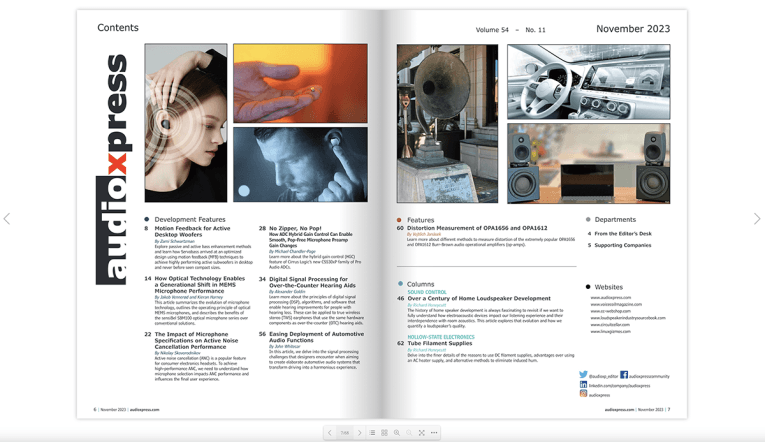
From another practical perspective, Zami Schwartzman, the founder of Servobass, shares his journey into the application of Motion Feedback (MFB) methods for active subwoofers. In his article he explores passive and active bass enhancement methods and how Servobass arrived at an optimized design using MFB techniques to achieve highly performing active subwoofers in desktop and compact sizes. A solution that is now available to be licensed by the industry.
Continuing with more audio electronics, Vojtěch Janásek writes about alternative methods to measure distortion of the extremely popular, and highly specified OPA1656 and OPA1612 Burr-Brown audio operational amplifiers. The THD of the OPA1656 is close to -160dB according to the manufacturer's datasheet. Such low distortion cannot be measured directly with any available equipment, so different methods have been developed and tested for inverting and non-inverting amplifiers with resolution below -170dB.
In his Sound Control column, Richard Honeycutt writes about "Over a Century of Home Loudspeaker Development." The history of home speaker development is always fascinating to revisit if we want to fully understand how electroacoustic devices impact our listening experience and their interdependence with room acoustics. This article explores that evolution and how we quantify a loudspeaker's quality.
And for those interested in his Hollow-State Electronics column, Richard Honeycutt delves into the finer details of the reasons to use DC filament supplies, the advantages over using an AC heater supply, and alternative methods to eliminate induced hum.

Again, all the content contained in every issue of audioXpress is the reason why, month after month, this publication continues to reinforce its role as an essential resource for the audio industry. To sustain that work, month after month, 12 times per year, audioXpress requires your support.
Subscribe if you haven't yet in order not to miss future issues, or renew your subscription, because audioXpress is only going to get better. Subscribing to the digital online version allows immediate access and is available here: audioXpress Subscription Services
If you wish to buy a single printed issue or the complete audioXpress archive on USB, from 2000 to 2023 (yes, including the latest issue), just visit our online shop at www.cc-webshop.com
Don't miss out, get your copy of audioXpress right now at www.gotomyxpress.com



